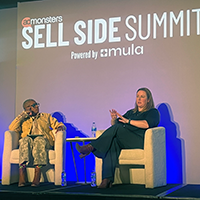Consumers may see loyalty programs as a necessary evil for getting a sale price at a grocery store, or as a chance to belong to an elite group.Consumers may see loyalty programs as a necessary evil for getting a sale price at a grocery store, or as a chance to belong to an elite group.
Regardless of how they position it, loyalty marketing is important to brand marketers—especially since new technology is helping contain costs.
Loyalty marketing programs have seen an annual growth rate of about 5% since 2002, according to Colloquy, a newsletter published by Frequency Marketing, Milford, OH.
Research by Maritz Loyalty Marketing, St. Louis, suggests that 66% of consumers say that discounts are the reason they participate in loyalty programs. But another Maritz poll hints that consumers just as easily cancel out of loyalty programs because of the length of time it takes to build up reward points. In the crucial 18-24 age group, 79% of consumers drop out from impatience.
“Marketers need to provide consumers with realistic and achievable goals,” says Gail Sneed, Maritz’s market development director when the study was published last September. “Particularly with the college-age demographic, it’s the chance to win or lose a lifelong customer.”
On the opposite end of the spectrum, Maritz Loyalty Marketing says that 70% of high-income earners ($125,000+) are more loyal to companies that offer rewards programs. With more disposable income, and therefore more opportunity to earn rewards, high-income earners are diligent about finding the program that best suits their needs and taking full advantage of the rewards offered.
But Patrick Brady, CEO of Charlotte, NC-based Stoneacre Partners, said that as more sophisticated technology comes about, the very definition of loyalty programs will be redefined, making more consumers happier.
With new technologies comes customization of loyalty programs for consumers. Instead of a cookie-cutter approach, consumers will be able to cherry-pick what they want their loyalty programs to do for them, Brady says.
“Consumers are demanding that their behavior credit them the way they would like to be credited,” Brady says. “The trend in loyalty marketing is connectivity between the consumer and the program, when it used to be data sampling. Before we had the capability to customize loyalty programs, all we had was sophisticated guessing as to what consumers wanted.”
In February, Stoneacre Partners launched the Official NASCAR Members Club, which NASCAR hopes will unite stock-car racing’s fan base of 75 million. Consumers sign up online or at Internet kiosks set up at racetracks, and choose their rewards structures and prizes.
As important, Brady notes that the customization of the Official NASCAR Members Club allows its patrons to change their options at will —offering a smoother exchange between brands and consumers.
Customization is also a reason gift cards have become such a hot loyalty reward.
“Individuals want a choice,” says Timothy Barefield, CEO of GiftCertificates.com, which partners with loyalty programs looking for rewards with more options. Barefield notes that 70% of loyalty program members who have an option of choosing the company’s SuperCertificate gift card take that option for the flexibility.
The SuperCertificate allows consumers to log into the company’s Web site, GiftCertificates.com, and redeem points for electronic or traditional gift cards from multiple retailers, including Bennigan’s, Famous Footwear, Reebok, Motherhood Maternity, Budget Car Rental.
“For us, loyalty marketing is a target area,” Barefield says. “We’ve had such great success with it.”
RFID technology will also have a bigger impact in loyalty marketing, experts say, especially on the retail front. MasterCard International is working toward incorporating MasterCard PayPass RFID technology into its NFL Extra Points loyalty credit card programs, allowing users to pay without swiping their card.
And the technology that fuels ExxonMobil’s Speedpass will grow in the future as more gasoline retailers and c-stores adopt their own versions of the technology, says Glenn Hausfater, managing director of Partners In Loyalty Marketing, Chicago.
“The cost of the technology keeps coming down,” Hausfater says. “It won’t be long before a retailer in either the grocery or department store segments jumps on it. —Tim Parry



